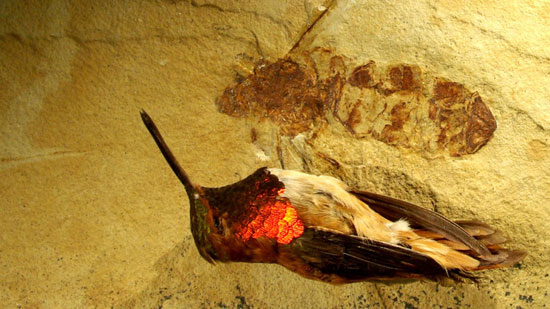Research on global warming through petrography
Four paleontologists from Canada and the United States have studied fossils of a giant ant in the Denver Museum, thereby understanding how global warming affects the distribution of life ago. about 50 million years.
The study was published on the May 4 edition of the journal Proceedings of the Royal Society . The team named this giant fossil is Titanomyrma lubei .
This winged queen lived in the Eocene century , about 50 million years ago. Its body is 5cm longer, equivalent to the size of a hummingbird and in a crawling posture. Currently only giant ant ants of an ant species in tropical Africa are so big.

Huge fossil ants are about the size of a small bird.(Source: Internet)
One of the study authors, Bruce Archibald, said: ' Surprisingly, this ant is crawling in an ancient forest, presumably the Wyoming forest, when the temperature there is as hot as in the heat zones. modern zone. In fact, all closely related fossil ants are found in hot climates in Europe and North America . '
The group of researchers investigated the habitats of the most modern modern ants and found that most of them live in tropical areas and show that there may be something that makes ants This must live in places with high temperatures.
During the Eocene period, many plants and animals moved between Europe and North America through a strip of land crossing the North Pole connecting these two continents. But the mystery is how these giant ants overcome the cold climate in the Arctic.
The research team said that the decisive factor is that many warming periods have occurred around this period. They seem to create recurring opportunities for hot climate-loving life between the two continents across the Arctic.
Bruce Archibald said the findings will help scientists get a more effective approach to understanding the effects of global warming on life.
Archibald said: ' Due to Earth's climate changes, we see destructive species living in the tropics expanding the scale of growth in the middle of the climate and the dragonflies intensifying export. show in the North Pole. Therefore, understanding the life forms adapted to global warming in the past will be increasingly important in the future . '
- Global warming delays the next ice age
- Global warming can erase the Olympics since 2085
- Video: 135 years of global warming summed up for more than 30 seconds
- Scotland faces 'apocalypse' because of global warming
- The reason for the worsening winter is despite the global warming climate
- Cover the sun to block ... global warming
- Where will the sea level be highest due to global warming?
- Earth warms, the Arctic will explode vegetation
- Nature helps curb the global warming
- Global warming threatens the safety of flights
- Global warming has terrible consequences
- Two Vietnamese granaries will be submerged in the sea after 5 years?
 Why do potatoes have eyes?
Why do potatoes have eyes? 'Tragedy' the world's largest carnivorous life: Death becomes ... public toilet
'Tragedy' the world's largest carnivorous life: Death becomes ... public toilet Tomatoes were once considered 'poisonous' for 200 years
Tomatoes were once considered 'poisonous' for 200 years Detecting microscopic parasites on human face
Detecting microscopic parasites on human face